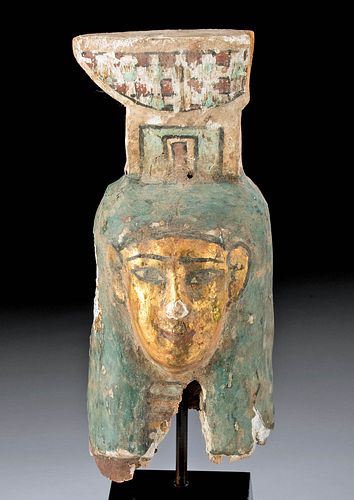Egyptian Ptolemaic Gilded Gesso / Wood Head of Nephthys
Lot 9a
About Seller
Artemis Fine Arts
686 S Taylor Ave, Ste 106
Louisville, CO 80027
United States
Selling antiquities, ancient and ethnographic art online since 1993, Artemis Gallery specializes in Classical Antiquities (Egyptian, Greek, Roman, Near Eastern), Asian, Pre-Columbian, African / Tribal / Oceanographic art. Our extensive inventory includes pottery, stone, metal, wood, glass and textil...Read more
Categories
Estimate:
$4,000 - $6,000
Absentee vs Live bid
Two ways to bid:
- Leave a max absentee bid and the platform will bid on your behalf up to your maximum bid during the live auction.
- Bid live during the auction and your bids will be submitted real-time to the auctioneer.
Bid Increments
| Price | Bid Increment |
|---|---|
| $0 | $25 |
| $300 | $50 |
| $1,000 | $100 |
| $2,000 | $250 |
| $5,000 | $500 |
| $10,000 | $1,000 |
| $20,000 | $2,500 |
| $50,000 | $5,000 |
| $100,000 | $10,000 |
| $200,000 | $20,000 |
About Auction
By Artemis Fine Arts
Oct 8, 2020
Set Reminder
2020-10-08 10:00:00
2020-10-08 10:00:00
America/New_York
Bidsquare
Bidsquare : Exceptional Antiquities, Asian, Ethnographic
https://www.bidsquare.com/auctions/artemis-gallery/exceptional-antiquities-asian-ethnographic-5796
Museum-worthy examples of Egyptian, Greek, Roman, Etruscan, Near Eastern, Far East / Asian, Pre-Columbian, African / Tribal,Oceanic, Native American, Spanish Colonial, Russian, Fossils, Ancient Jewelry, Fine Art, so much more! Artemis Fine Arts info@artemisgallery.com
Museum-worthy examples of Egyptian, Greek, Roman, Etruscan, Near Eastern, Far East / Asian, Pre-Columbian, African / Tribal,Oceanic, Native American, Spanish Colonial, Russian, Fossils, Ancient Jewelry, Fine Art, so much more! Artemis Fine Arts info@artemisgallery.com
- Lot Description
Egypt, Ptolemaic Period, ca. 332 to 30 BCE. A carved wooden head of a gorgeous form depicting Nephthys, sister of Isis, goddess of death and darkness, and one of the oldest deities in the Egyptian pantheon. The three-dimensional face presents with feminine features such as almond-shaped eyes outlined in black with elongated exterior canthi, thin brows sweeping across her brow, cupped ears, red-painted lips beneath a petite nose, and a rounded chin, all opulently accentuated with layers of fine gilding. Her turquoise tripartite wig has lappets that frame either side of a fragmentary wesekh pectoral collar, and atop her head is Nephthys' signature headdress which resembles a temple or estate layout. This head was perhaps part of a larger wooden figure which acted as a votive mourner inside the tomb of a deceased individual. Size: 3" W x 6.5" H (7.6 cm x 16.5 cm); 9.125" H (23.2 cm) on included custom stand.
The goddess Nephthys is one of the oldest deities of ancient Egypt and, accordingly, one of the most symbolically significant. She is the daughter of Geb (god of the earth) and Nut (goddess of the sky), and is the mother of Anubis, the jackal-headed god of embalming and the dead. Nephthys' association with death and darkness originates from the bipolarity of light and dark she shares with her sister Isis, the goddess of light and rebirth, and the symbols most-commonly associated with the goddess are the temple (as seen on her headdress), the hawk, and the sycamore tree.
Nephthys is so strongly linked with death that effigies of her likeness were regularly created and displayed during ancient Egyptian funerary ceremonies, and her portrait is one of four goddesses present in the tomb of Tutankhamen. In fact, her namesake cult, the "Cult of Nephthys," is even credited for creating some of the first professional funerary mourners, nicknamed the "hawks of Nephthys." Funerary figures like the example this head likely came from were elaborately decorated to pay homage as well as to protect the body of the deceased. Funerary carvings of Nephthys were often accompanied by matching carvings of her sister, Isis, with each being placed near on atop the ends of a sarcophagus.
Cf. The Brooklyn Museum, accession number 11.681; also The Metropolitan Museum of Art, accession number 12.182.23a
Provenance: private New York, New York, USA collection
All items legal to buy/sell under U.S. Statute covering cultural patrimony Code 2600, CHAPTER 14, and are guaranteed to be as described or your money back.
A Certificate of Authenticity will accompany all winning bids.
We ship worldwide and handle all shipping in-house for your convenience.
#159294Chipped areas of repair to back of head and wig, with light adhesive residue along break lines. Small area of overpainting to left cheek. Loss to one side of headdress and neck as shown. Chipping to painted gesso and gilt gesso, with fading to original pigment, light encrustations, a few hairline fissures, and inactive insect damage to interior of head. Great remains of original pigment throughout and gilding on face. Metal slot within head for mounting purposes.Condition
- Shipping Info
-
All shipping is handled in-house for your convenience. Your invoice from Artemis Gallery will include shipping calculation instructions. If in doubt, please inquire BEFORE bidding for estimated shipping costs for individual items.
-
- Buyer's Premium



 EUR
EUR CAD
CAD AUD
AUD GBP
GBP MXN
MXN HKD
HKD CNY
CNY MYR
MYR SEK
SEK SGD
SGD CHF
CHF THB
THB














